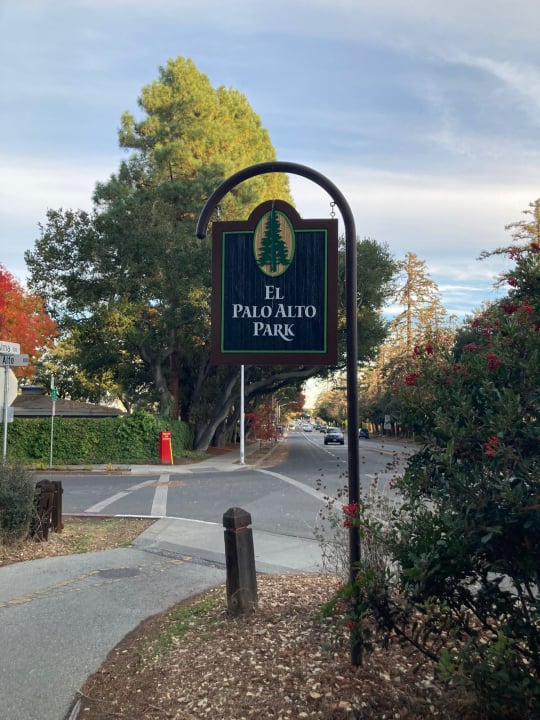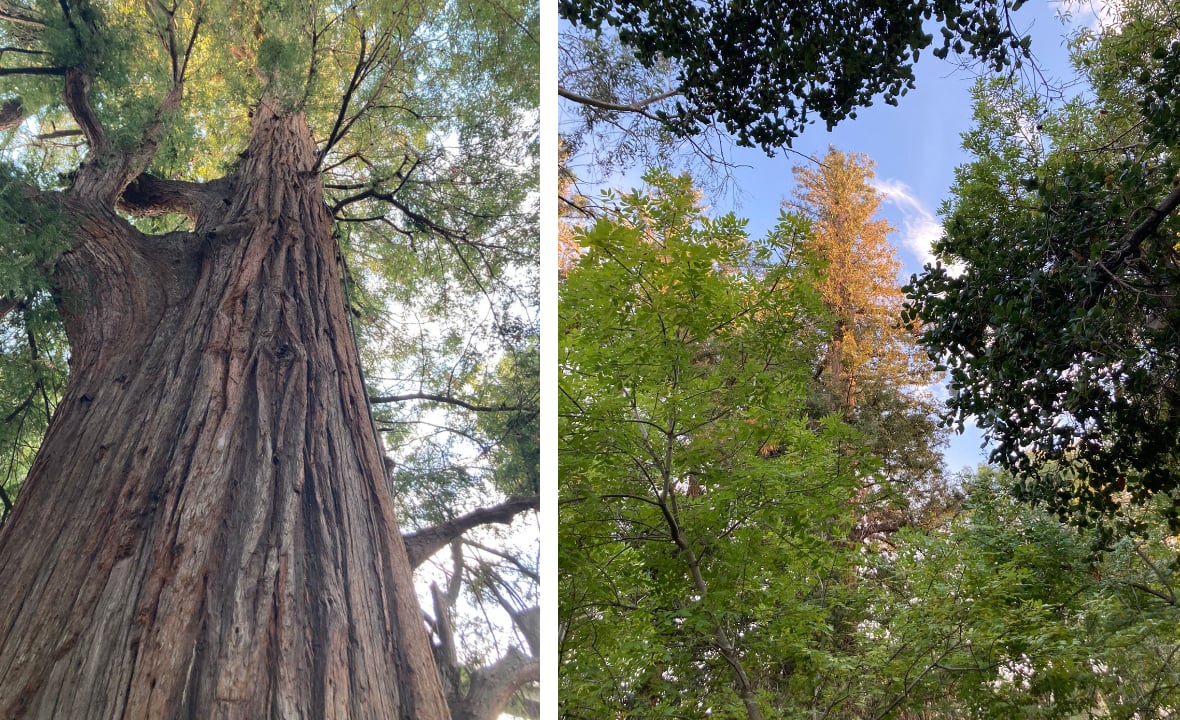



It’s hard to imagine a landscape as it might have been 50 years ago, let alone a century before. But if one redwood tree could speak, it would tell us about life as it was ten centuries ago. Meet the 1081-year-old El Palo Alto, a coastal redwood tree in Palo Alto, San Francisco Bay Area, which wears its cloak of fame lightly. Just like the tree.
Walking along with a newly minted Stanford graduate to the smallish El Palo Alto Park, where the tree stands with just a bronze plaque marking its existence, the graduate confessed to me about not being aware of the tree. “Are you sure we are looking at the tree?” she asked when we stood in front of it.
 (Photo: Jayanthi Madhukar)
(Photo: Jayanthi Madhukar)
The plaque confirms: Under this giant Redwood, The Palo Alto, November 6th to 11th, camped Portola (Spanish explorer) and his band on the expedition that discovered San Francisco Bay. This was the assembling point for their reconnoitering parties. Here in 1774 Padre Palou erected a cross to mark the site of a proposed mission (which later was built at Santa Clara)…
There is more but it’s no surprise that the Santa Clara County declared the tree as a point of Historical Interest. Just to give an idea of how old the tree is, it was already over 800 years old when the American Constitution was signed in 1787.
It's been around for so long that it could have toppled over so many times. For one, its location isn’t ideal. Experts say the tree is far away from its kin who thrive in wetter climes. Probably, a redwood seed may have floated down the mountains by the San Francisquito Creek and taken root there, nourished by the creek’s water.
And talking of location, the tree stands quite close to the suburban Caltrain Rail whose trains thunder past. This means the tree has weathered fumes from coal, oil and diesel as the rail system chugged along to its present avatar. The rail plans to turn electric next year so it’s still inhaling the diesel fumes.
In 1814, the tree stood at 162.2 feet but today it is 120-feet tall. The plaque shows the tree with twin trunks but there’s just one visible. It was reported that the twin trunk fell in 1886 after 24 inches of rain was received over three months. That’s when a dendrology ring-count was done, indicating an age of 960 years.
The tree has since survived the railroad construction, receding water table in the 60s, and a graffiti attack in 2010.
 (Photo: Jayanthi Madhukar)
(Photo: Jayanthi Madhukar)
Over the past centuries, the tree has received help from arborists. There is the legendary George Hood of Palo Alto, a pioneering arborist – in fact, a local guide told me that it’s his vision which has made Palo Alto greener than other towns nearby – whose father watered El Palo Alto two days a week from 1935-55, and later, the son created a plumbing system that sent water up the trunk and bathed it in mist through a sprinkler system. It was dubbed as ‘Fool the Redwood’ plan since a redwood drinks water from its roots and the crown, a given in the coastal climes. Considering the way the tree looks, the plan seems successful so far. Other efforts have been executed including capping nearby wells to bring the water table up, using ground penetrating radar to check the health of the tree’s interior, a camera-mounted drone’s regular inspections of the crown and placing a prism at the top of the tree to monitor its stability.
The tree has had termite treatments, fertility treatments to increase absorbing root surface area, and regular pruning. A fortified wall has been built to keep the creek from taking out the roots and toppling the tree. The tree’s seedlings have been nurtured and its progeny now grow in Jacksonville in Florida as a way to continue its legacy, just in case the tree actually topples over.
“Wait a minute, El Palo Alto is the tree of Stanford,” the Stanford graduate said in an ‘Aha’ moment. And so it is. It appears as the symbol of Palo Alto as well as its famous university. Since the 1970s, one Stanford student is appointed as the mascot (the Stanford Tree has its own Twitter account!) of the marching band who then performs at the college games with abandon.
Stanford has decided to suspend the Tree for walking out onto the field last game with a sign reading 'Stanford Hates Fun'. Tree socials will be inactive for the next few months. See y'all soon. .— Stanford Tree (@DaStanfordTree) October 31, 2022
Incidentally, this year’s tree was suspended for displaying a banner that read ‘Stanford hates Fun’. This 'Tree' tradition is predated by another one which was again to do with Stanford students. Since the Stanford University was founded in 1885, there were annual contests to fix the class flag on top of the tree. That stopped in 1909 after a student got stuck on the top of the tree and was marooned there for the night and had to be rescued by other students.
Standing in front of it, El Palo Alto seems rather unremarkable and not so different from other redwoods nearby. It’s easy to understand why many doubt if it is ‘that’ tree. But the tree has encapsulated the essence of the pioneering spirit of Palo Alto and the Bay Area itself. While tech companies in the area have been struggling and some veering into self-destruct mode, senor El Palo Alto shows how to be an unlikely survivor. Just hold on, it seems to say, and get help.
Discover the latest Business News, Sensex, and Nifty updates. Obtain Personal Finance insights, tax queries, and expert opinions on Moneycontrol or download the Moneycontrol App to stay updated!
Find the best of Al News in one place, specially curated for you every weekend.
Stay on top of the latest tech trends and biggest startup news.